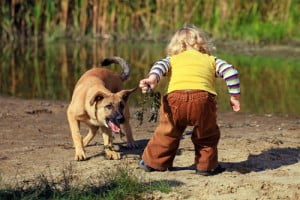Teach your Children How to Avoid Dog Bites
Man’s best friend sometimes just isn’t. Dogs are one of the most popular companion animals in America, yet over four million people across the country are bitten each year, according to the American Veterinary Medical Association. Children and senior citizens are the most vulnerable in dog attacks, as well as the most commonly bitten.
It’s not hard to understand why children are bitten so often. Dogs are small, furry and cute. Children often run up to unfamiliar dogs to make friends without a second thought. Unfortunately, not all dogs warm up to people as quickly, and some can become aggressive without warning. Danger does not come only in the form of an unfamiliar dog, however. Most dog bites occur from a dog that the victim knew, and an attack may result from an everyday activity, such as playing with or cuddling the dog. As a precaution it may be a good idea to teach your children ways to avoid dog bites.
Tips to avoid dog bites
Here are some tips on dog safety, provided by The Humane Society of the United States, that you should discuss with your kids. Keep this information in mind for yourself as well.
• Never run up to a dog you don’t know. Understand that even if you are not approaching a dog, an aggressive or scared one might run up and bite.
• If an unfamiliar dog becomes aggressive, look at the ground and become as still as a tree. Don’t look a dog in the eye. Wait until the dog loses interest, or try to back away slowly.
• If the dog attacks, try to “feed” it your backpack or jacket to protect yourself. Drop to the ground and protect your head and neck with your arms.
• Never bother a dog while it is eating, sleeping, or taking care of puppies.
• Don’t play roughly with the family dog. Even a friendly dog may accidentally bite or become provoked during aggressive play.
• Give dogs their space and understand that they don’t often like being hugged or leaned on. Invite the dog to come into your space, instead of getting into its face.
Understanding canine body language is a useful skill to have in avoiding trouble. In a future post, we’ll discuss the types of body language dogs use to communicate friendliness, fear, aggression, and more. Our strong hope is that you and your loved ones may enjoy the family pooch without getting hurt. If you are injured by another person’s dog, the dog owner may be held liable for damages. Contact our Tampa dog bite attorneys at Wagner, McLaughlin & Whittemore to discuss your case.


